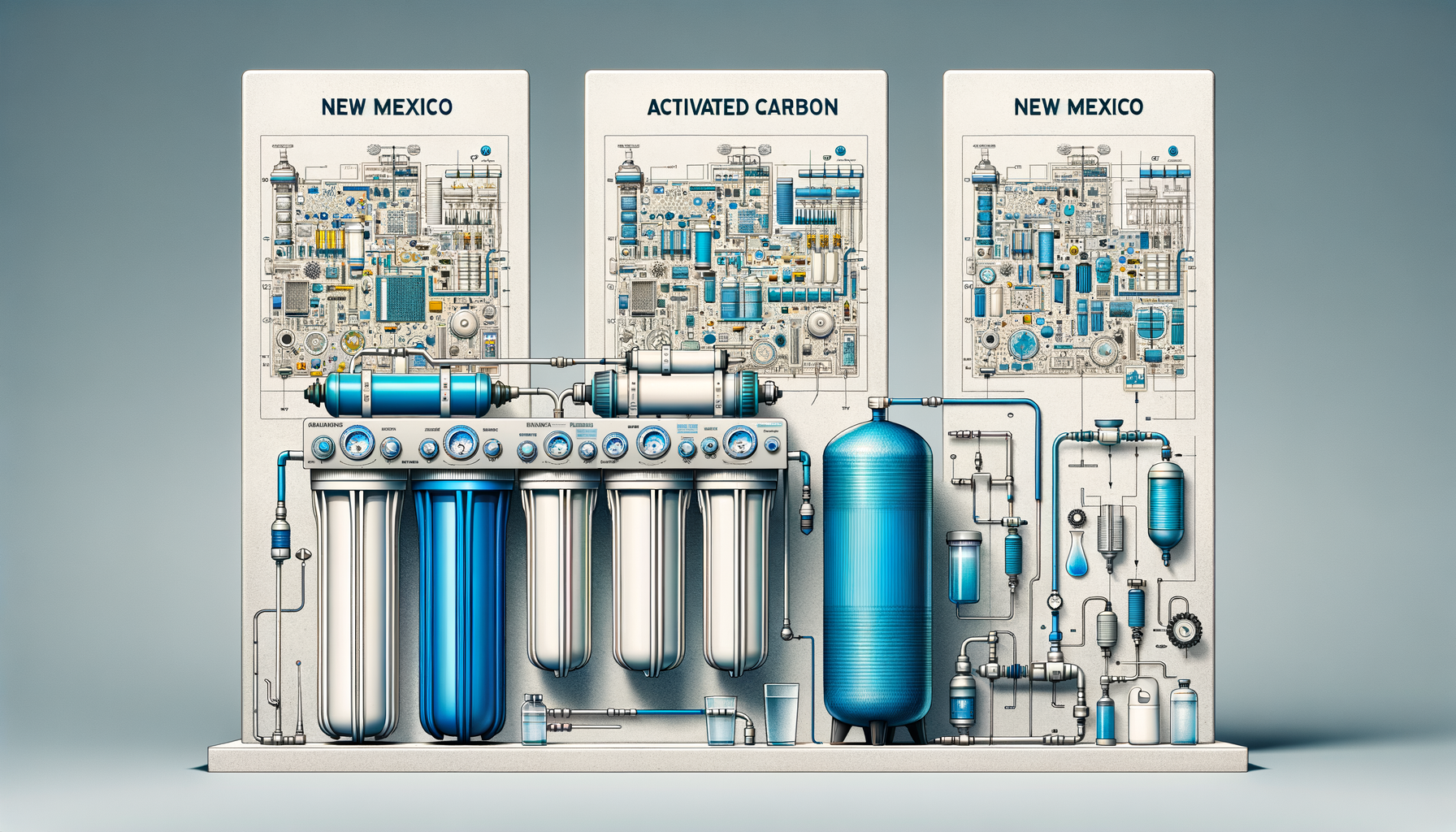Comprehensive Guide to Water Quality in New Mexico State: Contaminants, Issues, and Water Filtration Solutions
by Ryan Moreau / updated February 14th, 2025
New Mexico, known for its stunning deserts and rich cultural heritage, faces unique water quality challenges due to its arid climate and geological composition. The state’s primary water sources include a mix of surface water and groundwater, both of which are vital for sustaining its communities, agriculture, and ecosystems. With increasing concerns over contaminants like arsenic, uranium, and nitrates, it’s crucial for residents to understand the state’s water quality landscape. This comprehensive guide delves into New Mexico’s water sources, common contaminants, regional challenges, and effective filtration solutions. Begin by using our Water Quality Tool to get a customized analysis of your local water conditions.
Overview of New Mexico’s Water Sources
New Mexico’s water supply system is as diverse as its landscapes, comprising:
- Groundwater Aquifers: Groundwater accounts for about 87% of the state’s water withdrawals, serving as a critical source for drinking water, agriculture, and industry.
- Surface Water: Rivers such as the Rio Grande, Pecos, and San Juan are essential for irrigation and recreation, though they contribute less to municipal water supplies due to variable flow rates.
- Reservoirs: Man-made reservoirs like Elephant Butte Lake store surface water for irrigation and urban use, helping to manage the state’s limited water resources.
- Rainwater Harvesting: In rural areas, capturing rainwater is a supplementary source, especially important given the low annual precipitation.
Maintaining water quality amid scarcity requires diligent management and innovative treatment solutions to address both natural and human-induced contaminants.
Common Water Quality Contaminants in New Mexico
Due to its unique geology and industrial activities, New Mexico’s water sources may contain a variety of contaminants. To better understand potential issues in your area, start with our Water Quality Tool and then review these common concerns:
1. Arsenic
Arsenic is one of the most pervasive contaminants in New Mexico’s groundwater, primarily due to the state’s volcanic geology. Long-term exposure can lead to serious health problems, including skin conditions and increased cancer risk.
Water Filtration Options for Arsenic: Reverse Osmosis Water Filters, Water Distillers
2. Uranium and Radionuclides
Natural deposits of uranium and other radionuclides in New Mexico can leach into groundwater. Exposure may increase the risk of kidney damage and cancer.
Water Filtration Options for Uranium: Reverse Osmosis Systems, Activated Alumina Filters
3. Nitrates
Agricultural activities and septic systems contribute to elevated nitrate levels in some regions. High nitrate levels are particularly dangerous for infants, causing conditions like methemoglobinemia or “blue baby syndrome.”
Water Filtration Options for Nitrates: Reverse Osmosis Systems
4. Fluoride
While fluoride is often added to water to promote dental health, excessive natural fluoride levels in New Mexico’s groundwater can lead to fluorosis, affecting teeth and bones.
Water Filtration Options for Fluoride: Reverse Osmosis Systems, Activated Alumina Filters
5. Hard Water Minerals
High concentrations of calcium and magnesium result in hard water, common throughout New Mexico. Hard water affects plumbing systems, reduces appliance efficiency, and can cause skin irritation.
Water Treatment Options for Hard Water: Water Softeners
6. Perchlorate
Perchlorate contamination originates from military and industrial sites, as it’s a component of rocket fuel and explosives. It can disrupt thyroid function and hormone production.
Water Filtration Options for Perchlorate: Ion Exchange Filters, Reverse Osmosis Systems
7. Volatile Organic Compounds (VOCs)
VOCs such as benzene, toluene, and xylene enter water supplies from petroleum and chemical spills, industrial discharges, and improper waste disposal. These contaminants pose significant health risks including liver and kidney damage.
Water Filtration Options for VOCs: Activated Carbon Filters
8. Microbial Contaminants
Private wells, particularly in rural areas, may be susceptible to bacterial contamination from septic systems and livestock operations. Pathogens like E. coli and Giardia can cause severe gastrointestinal illness.
Water Filtration Options for Microbial Contaminants: Ultraviolet (UV) Water Purifiers, Reverse Osmosis Systems
9. Sulfates
Sulfates naturally occur in New Mexico’s groundwater and can cause a laxative effect when consumed in high concentrations. They also contribute to scale buildup in pipes and appliances.
Water Treatment Options for Sulfates: Reverse Osmosis Systems, Water Distillers
Regional Water Quality Challenges in New Mexico
New Mexico’s varied landscapes and industrial sectors contribute to region-specific water quality issues. According to the New Mexico Environment Department (NMED) and the Environmental Protection Agency (EPA), some key challenges include:
1. Northwest New Mexico: Uranium Mining Legacy
Areas like the Grants Mineral Belt have a history of uranium mining, leading to contamination of groundwater with radionuclides. Local communities, including Native American reservations, face ongoing risks from these legacy pollutants. (EPA – Navajo Nation Uranium Cleanup)
2. Agricultural Valleys: Nitrate Contamination
The Mesilla and Española Valleys, known for agriculture, experience nitrate runoff from fertilized fields and dairy operations, affecting local aquifers and private wells.
3. Los Alamos Area: Industrial Chemicals and Radionuclides
The Los Alamos National Laboratory area has concerns over legacy waste, including radionuclides and solvents that potentially contaminate groundwater and surface water. Ongoing monitoring and cleanup efforts are in place. (Los Alamos National Laboratory Environment Programs)
4. Southern New Mexico: Arsenic and Fluoride
Regions like Doña Ana County have naturally high levels of arsenic and fluoride due to the volcanic rock formations affecting groundwater quality.
General Water Characteristics in New Mexico
New Mexico’s arid climate and geological formations contribute to specific water characteristics that residents should be aware of when selecting water treatment options:
1. Water Hardness
Hard water is prevalent across New Mexico due to the high mineral content in groundwater sources. This not only affects the taste of water but also leads to scale buildup in plumbing and appliances, potentially reducing their lifespan.
For households dealing with hard water, water softeners are recommended. If you’re unsure about the necessity or type of water softener for your home, use our Water Softener Calculator for personalized advice.
2. High Total Dissolved Solids (TDS)
The concentration of total dissolved solids in New Mexico’s water is often higher than national averages due to the natural dissolution of minerals. Elevated TDS can affect water taste and may interfere with some industrial processes and home appliances.
- Taste and Aesthetics: High TDS can give water a salty or bitter taste.
- Appliance Wear: Can lead to scaling and reduced efficiency in water heaters and dishwashers.
Reverse osmosis systems are effective at reducing TDS levels, providing cleaner, better-tasting water.
3. Limited Surface Water Availability
Due to low rainfall and high evaporation rates, surface water sources are limited and variable. This scarcity increases reliance on groundwater, which is more susceptible to contamination from natural and human-made sources.
- Drought Conditions: Frequent droughts strain water supplies and can concentrate contaminants.
- Over-extraction of Groundwater: Can lead to reduced water quality as deeper, more mineralized water is drawn into wells.
Regular water testing and appropriate filtration systems are essential to ensure safe drinking water in these conditions.
Utilizing the Water Quality Tool for New Mexico Residents
Understanding your local water quality is crucial in New Mexico due to the state’s complex water challenges. Our Water Quality Tool allows residents to:
- Input their zip code for a comprehensive analysis of nearby water sources
- Access data on common contaminants found in local water supplies
- Receive tailored recommendations for filtration systems based on specific water quality issues
Recommended Filtration Solutions for Common New Mexico Contaminants
Given the prevalent contaminants in New Mexico, the following filtration systems are highly recommended to ensure safe, clean water:
1. Reverse Osmosis Systems
Reverse Osmosis Systems are highly effective in removing a broad spectrum of contaminants, including arsenic, uranium, nitrates, fluoride, and sulfates. They are an excellent choice for both point-of-use and whole-house applications.
2. Water Softeners
Water Softeners address the widespread issue of hard water by reducing calcium and magnesium levels, protecting plumbing systems and improving appliance efficiency.
3. Activated Carbon Filters
Activated Carbon Filters effectively remove VOCs, pesticides, and improve the taste and odor of water.
4. Ultraviolet (UV) Water Purifiers
UV Water Purifiers are ideal for eliminating microbial contaminants, providing an added layer of protection especially for private well users.
Local Water Testing Services in New Mexico
Precise water testing is essential to identify the specific contaminants in your water supply. We recommend using SimpleLab for comprehensive water quality analysis. Their easy-to-use kits and detailed lab reports empower you to make informed decisions regarding water treatment options.
Case Studies: Addressing Water Quality Issues in New Mexico
Exploring real-world examples provides valuable insights into how water quality challenges are being managed across the state:
1. Albuquerque: Combating Arsenic in Municipal Water
The City of Albuquerque faced arsenic levels exceeding EPA standards due to natural geological formations. The city implemented centralized treatment facilities utilizing advanced filtration to reduce arsenic levels, ensuring compliance and public safety.
2. Rural Communities: Addressing Uranium Contamination
In the Navajo Nation and other rural areas impacted by historical uranium mining, community programs have been established to provide access to clean water through point-of-use reverse osmosis systems and education on water safety.
3. Dairy Farms in Eastern New Mexico: Managing Nitrate Runoff
Large dairy operations near Clovis and Portales contributed to nitrate contamination in groundwater. Collaborative efforts between farmers, state agencies, and environmental groups led to improved waste management practices and monitoring to protect water quality.
Call to Action
New Mexico’s unique water quality challenges—stemming from its arid climate, geology, and industrial history—necessitate proactive water management strategies. Understanding local water issues and implementing effective filtration solutions are critical steps in safeguarding your household’s health.
Start by entering your zip code into our Water Quality Tool for a detailed assessment of your water supply. Then, explore our filter review articles to identify the most suitable system for your needs. Finally, confirm your water’s safety with comprehensive water testing services to ensure you have the clean, safe water your home deserves.







